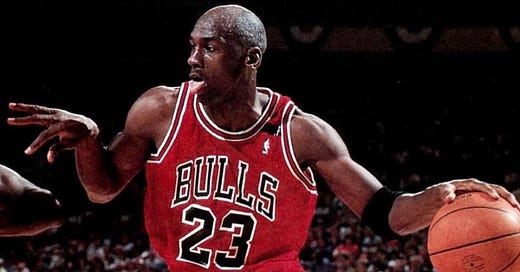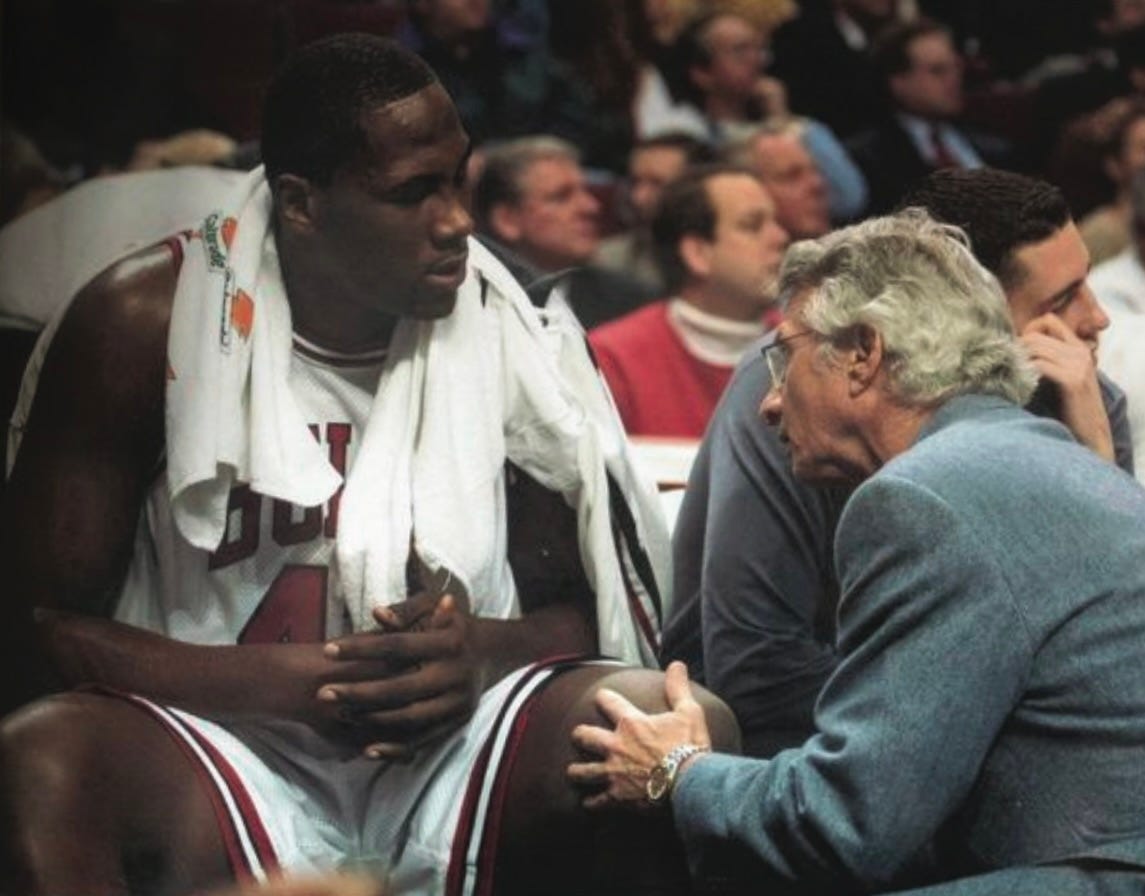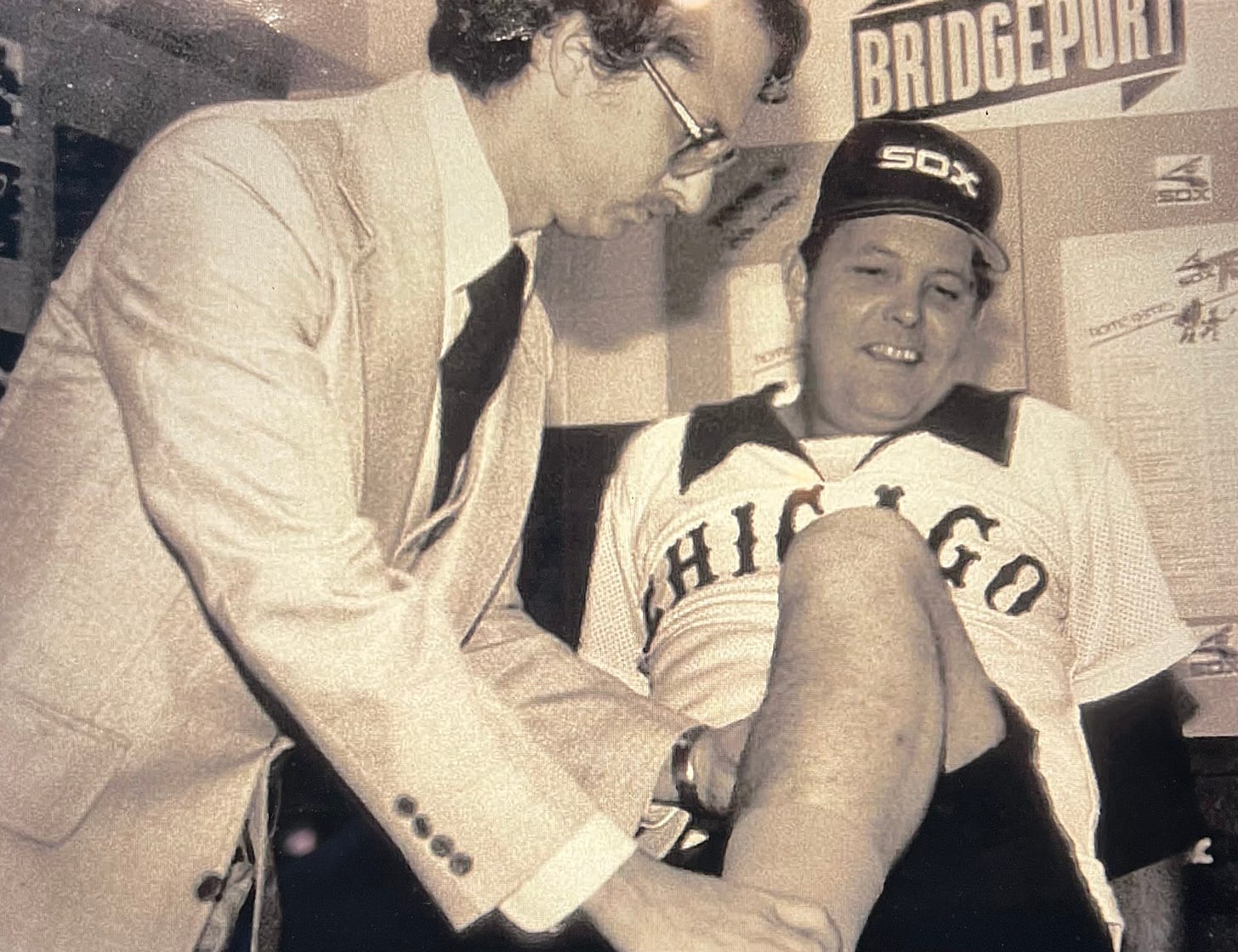When Michael Jordan Is Your Patient
"In treating and observing great athletes like M.J. and Wilbur Wood, I learned that humility is the human trait from which so many other virtues flow."
By Michael S. Lewis, M.D.
As a team orthopedic consultant for the Chicago Bulls during their fifth and sixth championship years, I closely observed Michael Jordan and his teammates to learn what qualities the greatest athletes possess. On one occasion, as a result of treating Michael, I received my own unforgettable lesson in humility:
May 25, 1998. The Chicago Bulls were playing the Indiana Pacers in the Eastern Conference Finals in Indianapolis, Indiana. Early in the game, Michael Jordan and Pacers center Rik Smits went up for a rebound. On the way down Smits poked Michael near his right eye, opening a nasty cut on his eyelid. Blood was pouring down his cheek.
As Michael and I walked off the court toward the visitors’ training room, my brain was racing between two options. One was to suture the eyelid laceration. This would mean injecting a local anesthetic, which would result in Michael’s eye being closed. He wouldn’t be able to return to the game. The other option was to apply strips of tape (called Steri-Strips) to the eyelid to stop the bleeding. Then he could play. However, the strips might not hold, and the blood might start flowing again.
Even though I had been in high-pressure situations before, I still experienced a massive adrenaline rush. Not only the game, but potentially the season, was at stake. In my mind’s eye, I could see the headline in the Chicago Tribune newspaper the next morning: “Bulls Lose Playoffs. Dr. Michael Lewis Dropped the Ball.”
Michael may have been the best basketball player in the world, but at that moment he was simply my patient, and I was simply his doctor. Easy to say now, but at the time, frankly, it took all my willpower to not feel intimidated by the situation.
I decided to recommend using the strips of tape instead of suturing the cut. This option would at least give Michael a chance to return to the game. The Steri-Strips in place, Michael went back out on the court. I didn’t breathe for the rest of the game, but the strips held. The Bulls went on to defeat the Indiana Pacers in seven games and win the conference finals. They ultimately defeated the Utah Jazz to win their sixth NBA championship.
Of course, there are more serious matters than winning a basketball game. In the operating room I have had to make judgments with far more consequential outcomes. At the same time, this decision could have negatively impacted the hopes and expectations of countless sports fans. It was a potent reminder that while my decision-making was appropriate, the outcome might not have turned out well. It was a humbling experience. I felt fortunate indeed.
On the subject of humility, in my experience, the athlete who most personified that quality was Wilbur Wood. He was one of the greatest major league baseball pitchers of his era. His 17-year Major League career started in 1961 with the Boston Red Sox. In 1967 he joined the Chicago White Sox, where he finished his career in 1978. I was a team orthopedic consultant for the White Sox from 1975 until 1981. Wilbur and I met in 1975, and we have remained in contact ever since.
Early in his career, Wood had relied on his fastball and his curveball. He learned to throw the extremely difficult knuckleball because, he said, it was the only way he could prolong his career in the Major Leagues. While pitching for the Chicago White Sox against the Yankees on July 20, 1973, Wood started both ends of a doubleheader. He was an All-Star pitcher who had won 20 or more games in four straight years.
In appearance, Wilbur Wood was an unlikely athlete. He was portly and smoked cigars, pitched left-handed and batted right-handed. Sportswriter Roger Angell once described him as “having the physique of an accountant or pastry chef on a holiday.” Wilbur would joke about his 39-inch waistline, saying that he needed all that weight in the middle to keep his balance.
When I asked him how he had become such a successful pitcher, Wilbur credited other people, saying he was successful because he had such good teammates — good hitters and good outfielders. He loved pitching in Comiskey Park because it had a big outfield that gave outfielders time to run under pop-up flies and catch them for an out. In Wilbur’s words, “It gave you room for a mistake.”
In spite of being one of the most famous baseball pitchers in his era, he was an unassuming person who treated everyone with respect. Even though both of us were in our mid-thirties and he was a year older than I was when we worked together on the team, he always addressed me as Dr. Lewis.
On May 9, 1976, Wood was struck directly on his kneecap by a line drive off the bat of Ron LeFlore, Detroit’s center fielder. My partner, Bill Meltzer, and I surgically repaired the shattered patella. When I talk with Wilbur these days, he recalls every detail of the surgery and his recovery as if it were yesterday.
It was a terrible injury from which many would not have returned. But Wilbur’s grit and his diligent adherence to his rehabilitation program allowed him to pitch two more seasons. In 1978, after a Major League career that spanned almost two decades, he said, in his typical low-key way, “I guess all good things must come to an end.”
In treating and observing athletes like Michael Jordan and Wilbur Wood, I learned the most valuable lesson about the great power of humility. As the author Thomas Moore once described it: “that low, sweet root, from which all heavenly virtues shoot.”
MICHAEL S. LEWIS, M.D. is a former Orthopedic Consultant to the Chicago White Sox and the Chicago Bulls, and the author of seven books.
**EDITOR’S NOTE: Since Oct 7, JEWDICIOUS has focused nearly exclusively on the war against Hamas. We will continue to share commentary on the conflict, while also carrying out our core mission of delivering content to readers on a broad range of issues and ideas.
Free subscriptions to JEWDICIOUS are available until the end of 2023!
From decoding politics to the cutting edge of wellness to the human angle on sports to parenting and personal relationships — plus our unsparing take on what’s happening in the Jewish world — the canvas at JEWDICIOUS is limitless. Our 18 scribes share one overarching goal: To present you with new ideas and slices of life that will hit your head or touch your heart!








MJ is a wonderful athlete and more important, a wonderful human being.